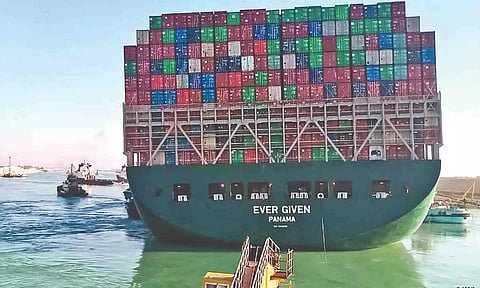

WASHINGTON: The Panama Canal connects the Atlantic Ocean with the Pacific. Its creation was a huge boon for global shipping. Before the canal was completed, a ship had to travel around the southern tip of South America, a much longer and more dangerous route. The sea around the stormy Cape Horn was a veritable ships’ graveyard for centuries. Thousands of sailors died there and countless ships were lost. But the passage through the Panama Canal shortened the trip by more than 13,000 km, saving money and time.
But now, climate change appears to be threatening this route. Every time the canal’s locks are opened, millions of liters of fresh water flow into the sea. As a consequence, the water level in the canal drops. It is eventually replaced by more water flowing in. However now residents, conservationists and meteorologists are all observing a decrease in rainfall in Central America as a result of climate change. Which means less water for the canal. And if the fresh water that flows out of the canal’s locks can no longer be replaced, then large ships will find it increasingly difficult to pass through.
The Panama Canal uses so much fresh water because ships have to go through a dozen locks that take them up or down 26 meters (85 feet). According to the consulting firm Everstream, which monitors and evaluates supply chains on behalf of international firms, around 200 million liters of water are needed for every ship passage through the canal. The Panama Canal Authority, which is responsible for the operation of the canal, has issued strict draft restrictions in recent months. The draft of a ship is the distance between the waterline and the bottom of the ship. This measurement determines how much water a ship needs to safely navigate. If a ship is loaded with heavy goods, it sinks deeper creating a greater draft.
Normal operating draft for the canal is 15.24 meters. At the start of May, authorities put out an draft adjustment advisory for the Neo-Panamax locks — the term refers to size limits of some of the largest ships going through the canal — based on projected water levels. Starting May 24, the largest ships that transit the canal will be limited to drafts of up to 13.56 meters. A week later on May 30, that will be reduced again to 13.4 meters. To make matters worse, the Everstream analysts do not expect the situation to improve for the rest of spring. In fact, things could get worse for the shipping business.
Hapag-Lloyd, a Hamburg, Germany-based shipping company, and other international shippers have responded by loading fewer containers in order to reduce the draft of their ships. To compensate for the loss of income, Hapag-Lloyd will introduce a surcharge of $500 per container going through the Panama Canal starting June. Trade experts fear a disruption to supply chains and longer transport times that will affect prices. Vincent Stamer takes a more relaxed view of water levels in the Panama Canal and possible consequences for global trade. “It won’t really be critical for the supply chains for the time being,” the economist from the Kiel Institute for the World Economy told DW.
It won’t be like in 2021, when the container ship Ever Given got stuck and blocked the Suez Canal. “The Panama Canal is not as important for the global economy as the Suez Canal,” Stamer explained.
In addition, 90% of world trade is moved across the world’s oceans and has demonstrated a relatively pronounced resilience in recent years. “After the multiple strains caused by ship congestion, port closures and lockdowns in recent years, the supply chains have recovered significantly,” he said.